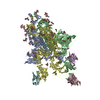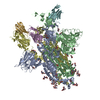[English] 日本語
 Yorodumi
Yorodumi- PDB-8g72: SARS-CoV-2 spike/Nb2 complex with 1 RBD up (local refinement at 5.6 A) -
+ Open data
Open data
- Basic information
Basic information
| Entry | Database: PDB / ID: 8g72 | |||||||||
|---|---|---|---|---|---|---|---|---|---|---|
| Title | SARS-CoV-2 spike/Nb2 complex with 1 RBD up (local refinement at 5.6 A) | |||||||||
 Components Components |
| |||||||||
 Keywords Keywords | VIRAL PROTEIN/IMMUNE SYSTEM / SARS-CoV-2 / VIRAL PROTEIN-IMMUNE SYSTEM complex / Nanobody | |||||||||
| Function / homology |  Function and homology information Function and homology informationMaturation of spike protein / viral translation / Translation of Structural Proteins / Virion Assembly and Release / host cell surface / host extracellular space / suppression by virus of host tetherin activity / Induction of Cell-Cell Fusion / structural constituent of virion / entry receptor-mediated virion attachment to host cell ...Maturation of spike protein / viral translation / Translation of Structural Proteins / Virion Assembly and Release / host cell surface / host extracellular space / suppression by virus of host tetherin activity / Induction of Cell-Cell Fusion / structural constituent of virion / entry receptor-mediated virion attachment to host cell / host cell endoplasmic reticulum-Golgi intermediate compartment membrane / receptor-mediated endocytosis of virus by host cell / membrane fusion / Attachment and Entry / positive regulation of viral entry into host cell / receptor-mediated virion attachment to host cell / receptor ligand activity / host cell surface receptor binding / fusion of virus membrane with host plasma membrane / fusion of virus membrane with host endosome membrane / viral envelope / virion attachment to host cell / SARS-CoV-2 activates/modulates innate and adaptive immune responses / host cell plasma membrane / virion membrane / identical protein binding / membrane / plasma membrane Similarity search - Function | |||||||||
| Biological species |   | |||||||||
| Method | ELECTRON MICROSCOPY / single particle reconstruction / cryo EM / Resolution: 5.6 Å | |||||||||
 Authors Authors | Ye, G. / Bu, F. / Liu, B. / Li, F. | |||||||||
| Funding support |  United States, 2items United States, 2items
| |||||||||
 Citation Citation |  Journal: J Virol / Year: 2023 Journal: J Virol / Year: 2023Title: Discovery of Nanosota-2, -3, and -4 as super potent and broad-spectrum therapeutic nanobody candidates against COVID-19. Authors: Gang Ye / Ruangang Pan / Fan Bu / Jian Zheng / Alise Mendoza / Wei Wen / Lanying Du / Benjamin Spiller / Brian E Wadzinski / Bin Liu / Stanley Perlman / Fang Li /  Abstract: The COVID-19 pandemic exposed limitations of conventional antibodies as therapeutics, including high cost, limited potency, ineffectiveness against new viral variants, and primary reliance on ...The COVID-19 pandemic exposed limitations of conventional antibodies as therapeutics, including high cost, limited potency, ineffectiveness against new viral variants, and primary reliance on injection-only delivery. Nanobodies are single-domain antibodies with therapeutic potentials. We discovered three anti-SARS-CoV-2 nanobodies, named Nanosota-2, -3, and -4, from an immunized alpaca. Nanosota-2 is super potent against prototypic SARS-CoV-2, Nanosota-3 is highly potent against the omicron variant, and Nanosota-4 is effective against both SARS-CoV-1 and SARS-CoV-2. In addition to their super potency and combined broad antiviral spectrum, these nanobodies are cost-effective, can be easily adapted to new viral variants through phage display, and can potentially be administered as inhalers. The Nanosota series are powerful therapeutic candidates to combat circulating SARS-CoV-2 and prepare for possible future coronavirus pandemics. | |||||||||
| History |
|
- Structure visualization
Structure visualization
| Structure viewer | Molecule:  Molmil Molmil Jmol/JSmol Jmol/JSmol |
|---|
- Downloads & links
Downloads & links
- Download
Download
| PDBx/mmCIF format |  8g72.cif.gz 8g72.cif.gz | 103.2 KB | Display |  PDBx/mmCIF format PDBx/mmCIF format |
|---|---|---|---|---|
| PDB format |  pdb8g72.ent.gz pdb8g72.ent.gz | 64.7 KB | Display |  PDB format PDB format |
| PDBx/mmJSON format |  8g72.json.gz 8g72.json.gz | Tree view |  PDBx/mmJSON format PDBx/mmJSON format | |
| Others |  Other downloads Other downloads |
-Validation report
| Summary document |  8g72_validation.pdf.gz 8g72_validation.pdf.gz | 1.4 MB | Display |  wwPDB validaton report wwPDB validaton report |
|---|---|---|---|---|
| Full document |  8g72_full_validation.pdf.gz 8g72_full_validation.pdf.gz | 1.4 MB | Display | |
| Data in XML |  8g72_validation.xml.gz 8g72_validation.xml.gz | 35.7 KB | Display | |
| Data in CIF |  8g72_validation.cif.gz 8g72_validation.cif.gz | 49.2 KB | Display | |
| Arichive directory |  https://data.pdbj.org/pub/pdb/validation_reports/g7/8g72 https://data.pdbj.org/pub/pdb/validation_reports/g7/8g72 ftp://data.pdbj.org/pub/pdb/validation_reports/g7/8g72 ftp://data.pdbj.org/pub/pdb/validation_reports/g7/8g72 | HTTPS FTP |
-Related structure data
| Related structure data |  29794MC  8g73C  8g74C  8g75C M: map data used to model this data C: citing same article ( |
|---|---|
| Similar structure data | Similarity search - Function & homology  F&H Search F&H Search |
- Links
Links
- Assembly
Assembly
| Deposited unit | 
|
|---|---|
| 1 |
|
- Components
Components
| #1: Antibody | Mass: 16750.008 Da / Num. of mol.: 1 Source method: isolated from a genetically manipulated source Source: (gene. exp.)   |
|---|---|
| #2: Protein | Mass: 136890.484 Da / Num. of mol.: 1 Source method: isolated from a genetically manipulated source Source: (gene. exp.)  Gene: S, 2 / Cell line (production host): 293F / Production host:  Homo sapiens (human) / References: UniProt: P0DTC2 Homo sapiens (human) / References: UniProt: P0DTC2 |
-Experimental details
-Experiment
| Experiment | Method: ELECTRON MICROSCOPY |
|---|---|
| EM experiment | Aggregation state: PARTICLE / 3D reconstruction method: single particle reconstruction |
- Sample preparation
Sample preparation
| Component | Name: SARS-CoV-2 spike/Nb2 complex with 1 RBD up / Type: COMPLEX / Entity ID: all / Source: MULTIPLE SOURCES |
|---|---|
| Molecular weight | Value: 0.425 MDa / Experimental value: YES |
| Source (natural) | Organism:  |
| Source (recombinant) | Organism:  Homo sapiens (human) Homo sapiens (human) |
| Buffer solution | pH: 7.5 |
| Specimen | Embedding applied: NO / Shadowing applied: NO / Staining applied: NO / Vitrification applied: YES |
| Vitrification | Cryogen name: ETHANE |
- Electron microscopy imaging
Electron microscopy imaging
| Experimental equipment |  Model: Titan Krios / Image courtesy: FEI Company |
|---|---|
| Microscopy | Model: FEI TITAN KRIOS |
| Electron gun | Electron source:  FIELD EMISSION GUN / Accelerating voltage: 300 kV / Illumination mode: FLOOD BEAM FIELD EMISSION GUN / Accelerating voltage: 300 kV / Illumination mode: FLOOD BEAM |
| Electron lens | Mode: BRIGHT FIELD / Nominal defocus max: 2400 nm / Nominal defocus min: 800 nm |
| Image recording | Electron dose: 40 e/Å2 / Film or detector model: FEI FALCON IV (4k x 4k) |
- Processing
Processing
| CTF correction | Type: PHASE FLIPPING AND AMPLITUDE CORRECTION | ||||||||||||||||||||||||
|---|---|---|---|---|---|---|---|---|---|---|---|---|---|---|---|---|---|---|---|---|---|---|---|---|---|
| 3D reconstruction | Resolution: 5.6 Å / Resolution method: FSC 0.143 CUT-OFF / Num. of particles: 25124 / Symmetry type: POINT | ||||||||||||||||||||||||
| Refine LS restraints |
|
 Movie
Movie Controller
Controller














 PDBj
PDBj





